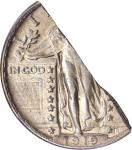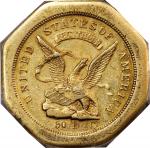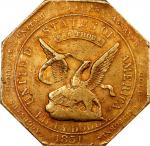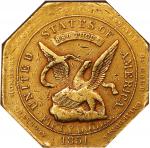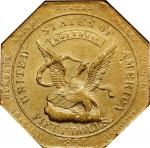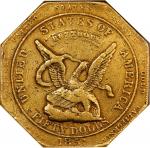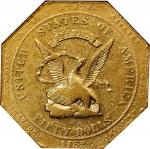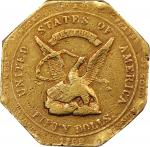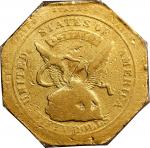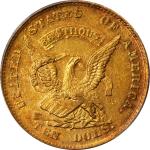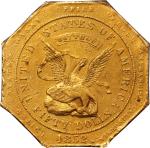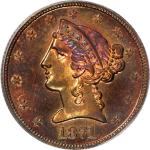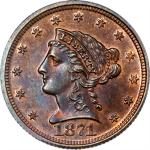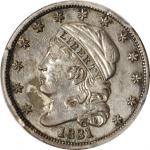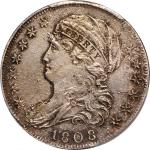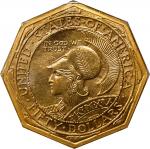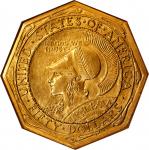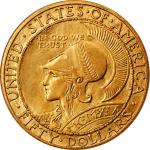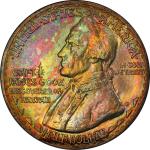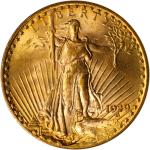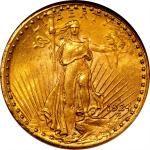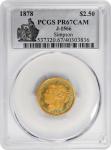1878 Pattern Quarter Eagle. Judd-1566, Pollock-1756. Rarity-8. Gold. Reeded Edge. Proof-67 Cameo (PCGS). <strong>Obv:</strong> A head of Liberty faces left with the motto E PLURIBUS UNUM around the border at the date 1878 below. Libertys hair is tied in a bun, and a band extending back from the forehead is inscribed LIBERTY. The point of the truncation touches the border before the date. <strong>Rev:</strong> An eagle with spread wings clutches an olive branch in its right talon and three arrows in its left. The legend UNITED STATES OF AMERICA is above and the denomination 2 1/2 DOLLARS is below. The diameter is larger than that of the contemporary regular issue quarter eagle (20.5 mm vs. 18 mm), but it is correspondingly thinner. A marvelous Superb Gem with a dusting of pale silver-olive iridescence to otherwise warm, vivid, reddish-orange color. Direct lighting calls forth playful reddish-rose undertones -- very attractive. The finish is boldly cameoed and contrasts frosty motifs with reflective fields. Fully struck, expertly preserved, and of the utmost significance.</p><p>This pattern type is attributed to George T. Morgan, and it was produced in accordance with the ideas on anti-counterfeiting introduced by Dr. J.T. Barclay on the 1860 Judd-271 pattern half eagle. Barclay believed that the most dangerous and difficult to detect method of counterfeiting U.S. gold coins was to hollow out the inner gold core and replace the extracted metal with an equal amount of platinum, a less valuable metal than gold at the time, but one which weighed about the same. It was thought that coins struck on thinner planchets would be more difficult to hollow out, thus making this method of counterfeiting less attractive. The Mint abandoned the idea in 1860, after only a few experimental pieces were struck. The attempt in 1878 met with the same fate, likely because the thinner coins provided difficult to produce in the same manner as the regular issue Type II gold dollars of 1854 to 1856.</p><p>The Judd-1566 gold striking is a legendary rarity. Although both Akers and Pollock listed two specimens in this metallic composition, later research published on the <em>uspatterns.com</em> website confirms that the provenance refers to only a single coin, offered here, and identifiable by a tiny lint mark or similar strikethrough in the reverse field to the left of the letter C in AMERICA. This type is usually represented by copper strikings, Judd-1567, although that attribution is rare in its own right with only about a dozen known. To simulate the unique gold specimen, some of the copper pieces have been gilt. There is no substitute for the real thing, however, and Judd-1566 is it -- the unique gold striking from these dies and a rare artifact of a failed Mint initiative to combat counterfeiting in the 19th century.</p> PCGS# 537320. NGC ID: 2AFJ. Ex Waldo C. Newcomer; "Colonel" E.H.R. Green, June 23, 1943; F.C.C. Boyd, via Burdette G. Johnson; King Farouk of Egypt; Sothebys sale of the Palace Collections of Egypt, February 1954, lot 329; Abe Kosoff; Dr. J. Hewitt Judd; Abe Kosoffs Illustrated History of U.S. Coins, 1961, lot 529; Dr. John E. Wilkison, 1962; Paramount International Coin Corporation, September 1973; A-Mark; Superiors session of Auction 90, lot 1454; Superiors Orlando Sale of August 1992, lot 494; Superiors January-February Auction of 1993, lot 1192; southern collection; Bob R. Simpson; Heritages sale of the Bob R. Simpson Collection, April 2021 CSNS Signature Auction, lot 4280.


